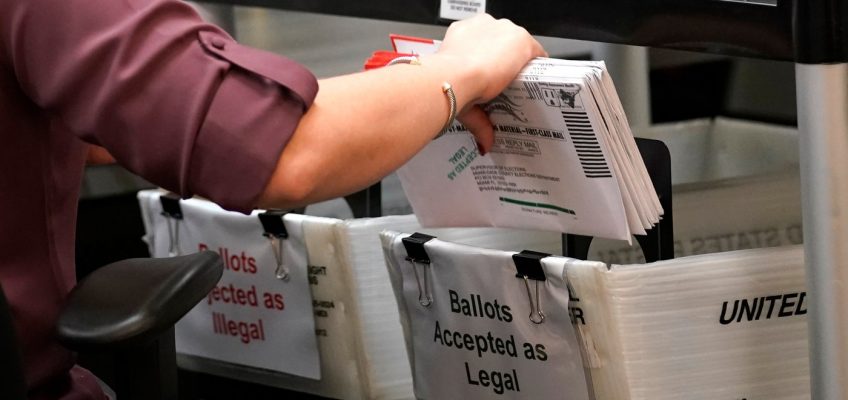State Sen. Victor Torres represents predominantly Hispanic Osceola County in central Florida. At Sunday Mass at his local church, immigrants often tell him they are scared to seek health care.
“They say, ‘My mother is ill, or my kid is sick, but I don’t have insurance,’’’ the Democrat said in an interview. “And I tell them, ‘You cannot be turned away. Go to the hospital. Don’t wait until the last minute when it’s too late.’”
Under the federal Emergency Medical Treatment & Labor Act (EMTALA), hospitals that have emergency departments and participate in Medicare — about 98% of hospitals in the United States — must provide emergency care to all patients, regardless of their ability to pay.
Florida and Texas, however, recently have required hospitals to ask patients about their immigration status. Supporters say the new policies will illuminate the costs of caring for people living in the country illegally, but critics say they are designed to dissuade immigrants from seeking care.
Florida Republican Gov. Ron DeSantis in May 2023 signed a sweeping immigration law that includes a provision requiring hospitals that accept Medicaid (which includes state funding) to collect data on patients’ immigration status. In August, Texas Republican Gov. Greg Abbott followed suit, by signing an executive order that requires Texas public hospitals to collect data on the costs they incur to provide emergency and inpatient care for people lacking permanent legal status.
“Texans should not have to shoulder the burden of financially supporting medical care for illegal immigrants,” Abbott said in issuing the order.
Data from Texas isn’t available yet. In Florida, however, a March report by the state Agency for Health Care Administration suggests patients lacking legal status account for a relatively narrow slice of overall health care spending.
In the second half of 2023, the agency found, immigrants without legal status accounted for 0.82% of hospital visits and 0.83% of emergency department visits. Florida hospitals spent a total of $69 billion in 2022, so based on those percentages, they spent about $566 million on care for immigrants lacking legal status.
The agency acknowledged that it did not know how much of that $566 million was so-called uncompensated care — that is, care not paid for by insurance or by the patient. It also did not find any correlation between a hospital’s level of uncompensated care and its percentage of patients living in the country illegally, nor was there an obvious connection between a hospital’s profitability and the percentage of its patients who were such immigrants.
In fact, the agency found that high levels of spending on uncompensated care were more associated with a county being rural than having a lot of immigrants lacking legal status.
“Research overwhelmingly suggests that immigrants don’t use as much health care and don’t use higher benefits than U.S.-born people,” said Drishti Pillai, associate director of the racial equity and health policy program at KFF, a health policy research organization. Pillai recently coauthored a KFF issue brief on the potential effects of the Florida and Texas measures.
KFF has found that immigrants spend less on health care than U.S.-born residents, and some research suggests that they end up subsidizing the health care of other U.S. residents through their payment of insurance premiums and taxes.
In both states, hospitals must inform patients that no matter how they respond to immigration-related questions, they will receive care. In Florida, hospitals also must tell patients that their answers won’t be reported to immigration authorities. Nevertheless, data from Florida suggests that the patients are being scared away by the prospect of being asked about their immigration status.
DeSantis has boasted that the policy has resulted in a decrease in Medicaid spending.
“We knew we’d get no support from the federal government, so we’ve had to do all these things at the state level,” DeSantis told Fox News in a June interview. “We made sure when you have people show up at the hospital that we’re asking about immigration status, and that’s caused the Medicaid expenditures to plummet by 50% in the state of Florida.”
A recent analysis of federal and state data backs up that assertion. In 2022, the year before the Florida law was enacted, state and federal Medicaid spending on emergency services for immigrants without legal status totaled $148.4 million. Between July 1, 2023, when the law took effect, and May 3, 2024, the total declined to $67 million, according to a Politico analysis of data from the Florida Agency for Health Care Administration and the U.S. Department of Health and Human Services. Medicaid, which provides health insurance to people with low incomes, is jointly funded by the federal government and states.
Florida Republican state Rep. Rick Roth, who runs a farm and employs hundreds of migrant laborers, voted for the measure. “I believe that the bill was mostly political, not punitive. It doesn’t prevent them from getting health care. It [creates] a perception that it’s going to be more difficult.”
Other supporters of the Florida law and Texas order say it makes sense to figure out how much money states are spending on care for immigrants here illegally — and if possible, to reduce it.
“Today, our health care system is overrun by illegals who came into our country, and the cost is borne by people like you and me, who are regular citizens, regular immigrants, who came here the right way,” Abraham George, the chairman of the Texas Republican Party — and an immigrant from India — said an interview.
‘A scare tactic’
Torres, the Florida lawmaker, pointed out that most immigrants and their families take on difficult work, contribute to the economy and pay taxes — without getting benefits such as Social Security, Medicaid or Medicare.
“This is a scare tactic by the Republicans on immigrants who are working every day and not asking for any handouts,” Torres said. “They’re working their tail off and just protecting themselves and their families.”
Illegal immigration is a central issue in the presidential campaign, and former President Donald Trump and other Republicans often talk about migrants draining public coffers by using benefits. Generally speaking, immigrants without permanent legal status cannot enroll in federally funded health care coverage under Medicaid, Medicare or CHIP (Children’s Health Insurance Program), and they can’t purchase plans under the Affordable Care Act. However, hospitals cannot turn them away in an emergency, and six states (California, Colorado, Illinois, New York, Oregon and Washington) plus the District of Columbia use state money to provide coverage to some adults regardless of their immigration status.
In Texas, even some Democrats worry about what hospitals and the state spend to care for immigrants without legal status who don’t have insurance and can’t pay out of pocket.
“These individuals are our fellow neighbors — they should never be denied treatment or demonized by extremists. But this can’t go unfunded in any way,” Texas Democratic state Rep. Eddie Morales told Stateline.
Morales said it’s legitimate for Texas to examine what it is spending on care for immigrants without legal status, and that it should help hospitals pay for uncompensated care. But he blamed Republicans in Washington for torpedoing a bipartisan bill that aimed to address the challenges at the border.
Long-term costs
Pillai, of KFF, said the Florida and Texas efforts might end up increasing those states’ health care costs if people lacking legal status avoid care but have to eventually visit the hospital in a worsened condition.
“This can cause routine situations to become more complex and expensive to treat later on, and it can lead to greater health care costs if an individual ends up presenting to the emergency room,” Pillai said.
In the issue brief, Pillai and her colleagues also note that immigrants without legal status play an outsize role in the Florida and Texas workforces, particularly in fields such as construction, farming and transportation.
That’s why Mike Oldham, president of the Texas Farmers Union, said he doesn’t support Abbott’s executive order. Oldham said that such measures create a climate of fear, such that migrant workers and their families who come to Texas to work “won’t even be seen out in the daytime.”
Related Articles
Hot days and methamphetamine are now a deadlier mix
Here’s why getting a COVID shot during pregnancy is important
Bakery that makes Sara Lee and Entenmann’s pushes back on FDA sesame warning
Don’t expect human life expectancy to grow much more, researcher says
The Medicare Advantage influence machine
“We have to have migrant labor. If you want milk and cheese and eggs and all the vegetables, you’ve got to have migrant labor,” Oldham said. “I can’t go pick up any white people that will do those jobs. They just won’t do them.”
Oldham said requiring hospitals to ask more questions on intake forms and hire interpreters to inquire about patients’ immigration status just creates unnecessary burdens for them.
Hospitals in Texas and Florida are too scared to discuss these policies, because they don’t want to be cast under a spotlight, especially if they serve people lacking legal status, said Deliana Garcia, a chief program officer at the Migrant Clinicians Network, a national nonprofit that focuses on health solutions for migrant populations and works with clinicians.
Garcia said the health care system can either support a person when they are relatively healthy, or provide more expensive care later on when their condition is more severe.
Besides, she said, “you don’t want someone who is ill circulating where they might then sicken you.”
Stateline is part of States Newsroom, a national nonprofit news organization focused on state policy.
©2024 States Newsroom. Visit at stateline.org. Distributed by Tribune Content Agency, LLC.




